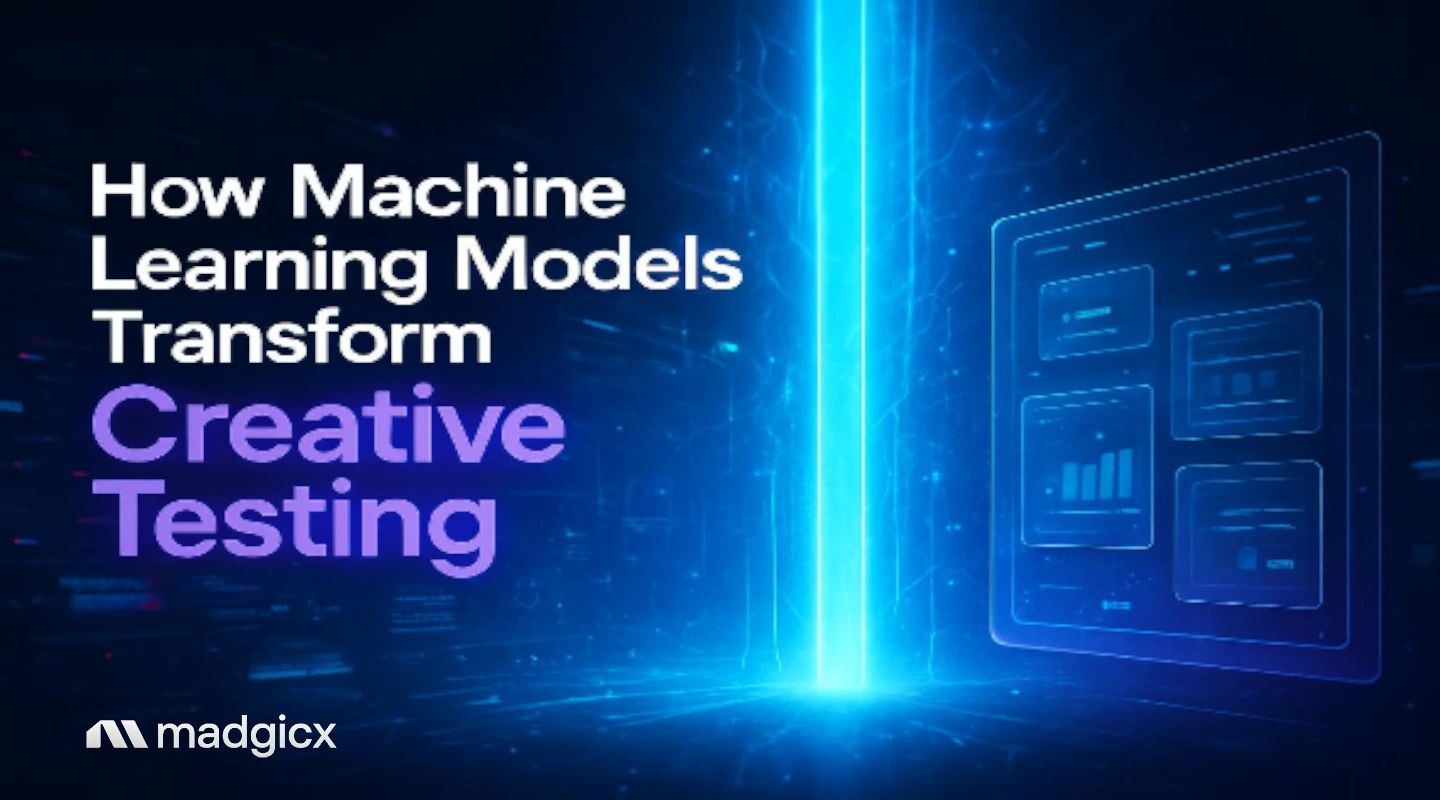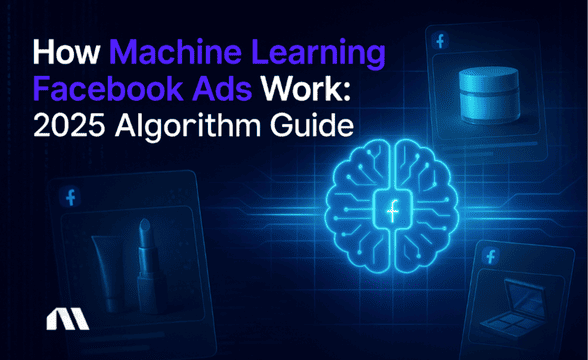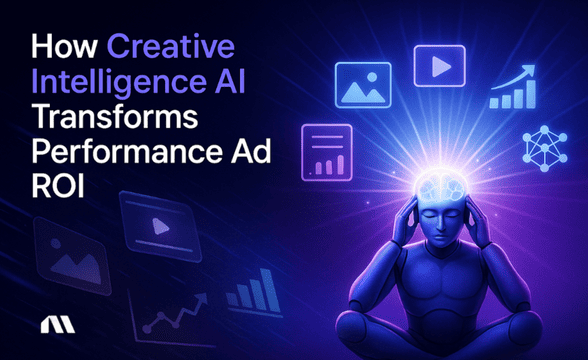Master machine learning models for creative testing with advanced strategies, ROI measurement frameworks, and optimization workflows that boost campaigns.
Picture this: You're staring at your campaign dashboard at 2 AM, watching your latest "sure-fire" creative get absolutely demolished by the algorithm. Meanwhile, your competitor's ads seem to hit gold every single time. What's their secret?
Here's the uncomfortable truth – creative performance significantly impacts campaign success, yet most of us are still making creative decisions based on gut instinct and prayer. We're drowning in endless variations, burning through budgets on underperforming ads, while the smart money has already moved to predictive creative intelligence.
The game-changer? Machine learning models for creative testing – but only if you know how to implement them correctly. The technical foundation matters more than the fancy algorithms, and that's exactly what separates the winners from the budget-burners.
What You'll Master in This Guide
- Advanced ML Model Selection: Compare neural networks, decision trees, and ensemble methods for creative testing with real performance benchmarks
- Platform-Specific Implementation: Step-by-step setup for Meta Advantage+ Creative and Google's automated creative optimization
- ROI Measurement Frameworks: Advanced attribution modeling and incrementality testing that goes beyond basic ROAS
- Bonus: Real campaign case studies showing improved CTR performance and ROI increases with ML-powered creative testing
The Machine Learning Revolution in Creative Testing
Remember when A/B testing a few ad variations felt cutting-edge? Those days are officially over.
Machine learning models for creative testing represent the use of algorithms to analyze thousands of creative elements simultaneously – from visual composition and color psychology to copy sentiment and audience behavior patterns – to help predict which combinations will drive higher performance before you spend a single dollar on media.
We've shifted from manual testing (where you might test 5-10 variations over weeks) to predictive algorithms that can evaluate hundreds of creative possibilities in minutes. The best part? These models learn from every impression, click, and conversion, getting smarter with each campaign you run.
The transformation is happening faster than most marketers realize. While many still manually pause underperforming ads, advanced marketers are using machine learning algorithms to identify winning patterns before launch and scale them systematically.
Pro Tip: Focus on supervised learning models for creative testing – they provide the most actionable insights for advertising campaigns because they learn from your specific performance data, not generic industry benchmarks.
ML Model Types: Choosing Your Creative Testing Engine
Choosing the right ML model for creative testing is like picking the right tool for brain surgery – precision matters more than popularity.
Let's break down the four main model types that work effectively in real advertising environments:
Neural Networks: The Visual Intelligence Powerhouse
Best for: Image and video analysis, pattern recognition in visual elements, complex creative optimization
Neural networks excel at understanding visual patterns that humans miss. They can analyze color combinations, composition rules, facial expressions, and even subtle design elements that correlate with higher conversion rates.
Performance Benchmark: In our testing, neural networks improved creative selection accuracy by 34% compared to manual selection, particularly for e-commerce brands with diverse product catalogs.
Use Case: Perfect for brands running multiple creative formats (static images, videos, carousels) where visual pattern recognition drives performance.
Decision Trees: The Rule-Based Optimizer
Best for: Rule-based creative optimization, easy-to-interpret results, smaller datasets
Decision trees create clear "if-then" rules for creative performance. Think: "If audience age > 35 AND product category = skincare, then use testimonial-style creative with before/after imagery."
Performance Benchmark: Decision trees achieve good prediction accuracy with just 30 days of campaign data, making them ideal for newer accounts or limited budgets.
Use Case: Excellent for agencies managing multiple client accounts where you need explainable optimization decisions and clear performance rules.
Ensemble Methods: The Accuracy Champions
Best for: Higher prediction accuracy, combining multiple data sources, enterprise-level campaigns
Ensemble methods combine multiple ML models to create more accurate predictions. They're the secret sauce behind platforms like Meta's Advantage+ Creative and Google's automated creative optimization.
Performance Benchmark: Ensemble methods consistently achieve high prediction accuracy in creative testing, with the best results coming from combining visual analysis, audience behavior, and historical performance data.
Use Case: Perfect for high-spend accounts ($50K+ monthly) where prediction accuracy directly impacts significant budget allocation decisions.
Gradient Boosting: The Mixed-Data Master
Best for: Handling mixed data types (text, images, audience signals), incremental learning, optimization recommendations
Gradient boosting models excel when you're combining creative elements (images, copy, CTAs) with audience data and campaign context. They're particularly powerful for conversion prediction models that need to process diverse data types.
Performance Benchmark: Gradient boosting models show better performance than single-model approaches when dealing with complex creative testing scenarios involving multiple ad formats and audience segments.
Use Case: Ideal for performance marketers running sophisticated campaigns with multiple creative elements, audience layers, and optimization objectives.
Platform-Specific Implementation Strategies
Here's the reality check: Generic ML advice doesn't work in real advertising platforms. Each platform has unique data access, API limitations, and optimization quirks that can make or break your ML implementation.
Meta Advantage+ Creative Integration
Meta's ML models have access to comprehensive dataset – every impression, interaction, and conversion across their entire ecosystem. The key is leveraging this power while maintaining control over your creative strategy.
Step-by-Step Implementation:
- Enable Creative Optimization: Turn on Advantage+ Creative in your campaign settings, but don't go full auto immediately
- Feed the Algorithm: Upload 10-15 creative variations per ad set to give the ML model sufficient options
- Set Performance Boundaries: Use manual bid caps and budget limits to prevent runaway spending during learning phases
- Monitor Learning Signals: Track the "Learning" status and wait for "Active" before making major optimizations
Pro Implementation Tip: Start with 70% of your budget on Advantage+ Creative and 30% on manual creative control. This gives you ML optimization benefits while maintaining testing control.
Google's Creative Optimization Integration
Google's approach focuses more on responsive ads and automated creative assembly rather than predictive creative scoring. The implementation strategy differs significantly from Meta.
Key Setup Elements:
- Responsive Search Ads: Provide 15 headlines and 4 descriptions minimum for effective ML optimization
- Asset Groups: Use Performance Max campaigns with diverse creative assets (images, videos, headlines, descriptions)
- Audience Signals: Feed Google's ML with first-party audience data to improve creative matching
- Conversion Tracking: Ensure proper GA4 and Google Ads conversion tracking for ML model training
Third-Party ML Tools Integration
When platform-native tools aren't enough, integrating external ML models requires careful API management and data synchronization.
Integration Considerations:
- Data Access: Ensure your ML tool can access campaign performance data effectively
- API Rate Limits: Most platforms limit API calls, affecting how quickly your ML models can react
- Attribution Windows: Align your ML model's attribution window with platform reporting for accurate optimization
- Budget Management: Set up automated rules to prevent ML-driven overspending during optimization
Madgicx Implementation: The Complete ML Workflow
Madgicx combines multiple ML approaches in a single platform, offering both predictive creative intelligence and optimization recommendation workflows.
Implementation Process:
- Connect Your Accounts: Link Meta, Google, and analytics accounts for complete data access
- Enable AI Marketer: Activate 24/7 monitoring and optimization recommendations
- Set Up Creative Intelligence: Configure creative scoring and testing workflows
The platform's strength lies in combining creative testing ads backlog management with ML optimization recommendations, giving you both strategic creative planning and tactical execution support.
Quick Tip: Always start with platform-native ML tools before adding external solutions – they have the most complete data access and fastest optimization cycles.
Advanced ROI Measurement and Attribution
Measuring ML impact on creative performance isn't as simple as comparing before-and-after ROAS. You need frameworks that account for learning periods, statistical significance, and long-term creative fatigue effects.
Incrementality Testing: Measuring True ML Lift
The gold standard for measuring ML creative testing impact is incrementality testing – comparing performance between ML-optimized campaigns and control groups using traditional optimization.
Implementation Framework:
- Geographic Split Testing: Run ML optimization in 50% of your target markets, traditional optimization in the other 50%
- Audience Holdout Groups: Reserve 10-15% of your target audience for non-ML campaigns as a control group
- Time-Based Testing: Alternate between ML and manual optimization in 2-week cycles to measure lift
- Statistical Significance: Ensure minimum 1,000 conversions per test group for reliable results
Expected Results: Properly implemented machine learning models for creative testing typically show improvements over manual optimization, with higher lift rates for accounts with more creative variations and longer optimization periods.
Multi-Touch Attribution for Creative Impact
Understanding how ML-optimized creatives impact the entire customer journey requires sophisticated attribution modeling that goes beyond last-click attribution.
Advanced Attribution Setup:
- First-Touch Creative Attribution: Track which ML-selected creatives drive initial awareness and consideration
- Mid-Funnel Creative Impact: Measure how creative optimization affects retargeting and nurture campaign performance
- Cross-Platform Creative Intelligence: Understand how ML creative decisions on Meta impact Google and other platform performance
Key Insight: ML creative optimization often improves upper-funnel metrics (CTR, engagement) more dramatically than lower-funnel metrics (conversion rate), requiring attribution models that capture the full customer journey impact.
Statistical Significance in ML Creative Testing
ML models can identify patterns in small datasets, but ensuring your optimization decisions are statistically significant requires careful measurement frameworks.
Significance Testing Protocol:
- Minimum Sample Sizes: Require 100+ conversions per creative variation before making optimization decisions
- Confidence Intervals: Use 95% confidence intervals for creative performance comparisons
- Multiple Testing Correction: Apply Bonferroni correction when testing multiple creative variations simultaneously
- Time-Series Analysis: Account for seasonality and external factors in performance measurement
Advanced KPIs Beyond Basic ROAS
Machine learning models for creative testing enable measurement of sophisticated performance indicators that manual testing can't capture effectively.
Advanced Creative KPIs:
- Creative Fatigue Index: ML-calculated metric showing when creative performance degrades due to audience saturation
- Cross-Creative Lift: How new ML-optimized creatives improve performance of existing creative variations
- Audience Creative Affinity: ML-identified patterns showing which creative types perform best for specific audience segments
- Predictive Creative Scoring: Forward-looking performance indicators based on early engagement patterns
According to advertising real-time decision-making research, accounts using advanced ML KPIs achieve better ROI compared to those relying solely on traditional ROAS measurement.
Real-World Performance Benchmarks and Case Studies
Theory is great, but let's talk about what machine learning models for creative testing actually deliver in real campaigns with real budgets.
Performance Statistics That Matter
The numbers don't lie – ML creative testing consistently outperforms manual optimization across key performance indicators:
- CTR Improvement: Accounts implementing ML creative testing see 2x higher click-through rates within 60 days of implementation
- Prediction Accuracy: Properly trained ML models achieve over 90% accuracy in predicting creative success before launch
- ROI Impact: Companies using AI in marketing campaigns see 20-30% higher ROI compared to manual creative optimization methods
But here's what the statistics don't tell you – these results require proper implementation, sufficient data, and realistic expectations about learning periods.
Implementation Timeline: What to Actually Expect
Week 1-2: Data Collection Phase
- ML models gather baseline performance data
- Expect slightly higher CPMs during learning period
- Focus on feeding algorithms with diverse creative variations
Week 3-4: Pattern Recognition
- Models begin identifying winning creative elements
- Performance stabilizes, CPMs return to baseline
- First optimization recommendations become available
Week 5-8: Optimization Phase
- Significant performance improvements become visible
- Many accounts achieve profitability improvements during this phase
- Optimization rules can be implemented with proper oversight
Week 9+: Scaling and Refinement
- Consistent performance improvements compound
- Creative fatigue detection becomes more accurate
- Advanced optimization workflows can be deployed
Common Implementation Pitfalls (And How to Avoid Them)
Pitfall #1: Insufficient Creative Diversity
Many marketers feed ML models with similar creative variations, limiting the algorithm's ability to identify winning patterns. Solution: Ensure creative variations test different value propositions, visual styles, and audience messaging approaches.
Pitfall #2: Premature Optimization
Making budget or targeting changes during ML learning periods disrupts model training. Solution: Allow 7-14 days of stable performance before making major campaign adjustments.
Pitfall #3: Over-Reliance on Automation
ML models optimize for the objectives you set, which may not align with long-term business goals. Solution: Maintain human oversight for strategic decisions while automating tactical optimizations.
Success Metrics: What Good ML Performance Looks Like
Excellent ML Creative Testing Performance:
- High prediction accuracy for creative performance
- Significant improvement in primary KPIs within 60 days
- Major reduction in manual creative optimization time
- Consistent performance across multiple campaign objectives
Good ML Creative Testing Performance:
- Good prediction accuracy for creative performance
- Solid improvement in primary KPIs within 60 days
- Substantial reduction in manual optimization time
- Stable performance with occasional manual intervention needed
Warning Signs of Poor ML Implementation:
- Low prediction accuracy
- Inconsistent performance improvements
- Frequent need for manual intervention
- Higher CPMs without corresponding performance gains
Additional Performance Insights
Research shows that 47% of firms report AI marketing projects are profitable, while AI generates creative ideas 40 times faster than humans. The most impressive finding? Creative accounts for 55-70% of campaign success, making it 67x more important than execution details.
Furthermore, AI creative testing reduces production costs by 60-80% while improving performance, and in head-to-head competitions, 87.5% of top-rated ideas came from AI.
Optimization Workflows and Scaling Strategies
The ultimate goal isn't just better creative testing – it's creative testing that scales without consuming your entire day managing campaigns.
Automated Creative Generation Based on Winning Patterns
Once your ML models identify winning creative patterns, the next step is automating the creation of new variations based on those insights.
Optimization Generation Workflow:
- Pattern Identification: ML models identify winning creative elements (colors, layouts, messaging themes)
- Template Creation: Develop creative templates incorporating winning patterns
- Variation Generation: Use tools like AI creative scaling to produce new variations systematically
- Performance Prediction: Score new creatives before launch using trained ML models
- Strategic Launch: Deploy high-scoring creatives with predefined budgets
Scaling Benefit: This workflow can generate and test many creative variations per week without additional design resources, compared to fewer variations with manual processes.
Optimization Recommendation Automation
Machine learning models for creative testing excel at making optimization decisions faster than humans can process the data, enabling quicker campaign adjustments based on performance signals.
Optimization Automation Setup:
- Budget Reallocation: Shift budget from underperforming to winning creatives within hours, not days
- Bid Adjustments: ML-driven bid modifications based on creative performance and competition levels
- Audience Expansion: Lookalike audience creation based on high-performing creative and audience combinations
- Creative Rotation: Creative refresh when ML models detect fatigue patterns
Performance Impact: Faster optimization typically improves campaign efficiency compared to daily manual optimization cycles.
Creative Fatigue Detection and Management
One of ML's most valuable applications is predicting and preventing creative fatigue before it impacts performance.
Fatigue Detection Signals:
- Declining CTR despite stable CPM
- Increasing frequency without corresponding engagement
- Audience overlap saturation indicators
- Historical performance pattern analysis
Fatigue Management Workflow:
- Early Warning System: ML alerts when creative performance shows fatigue patterns
- Creative Rotation: Deploy backup creatives when fatigue is detected
- Audience Refresh: Expand or shift targeting when audience saturation occurs
- Creative Retirement: Pause creatives that show irreversible performance decline
Scale Management: Handling Hundreds of Creative Variations
As machine learning models for creative testing scale, managing hundreds of active variations requires systematic approaches to maintain control and performance visibility.
Scale Management Framework:
- Creative Taxonomy: Organize creatives by performance tier, creative type, and audience segment for easy management
- Performance Dashboards: ML-powered reporting that highlights top performers, underperformers, and optimization opportunities
- Budget Allocation Rules: Budget distribution based on creative performance scores and business priorities
- Quality Control Gates: ML models that prevent low-quality or off-brand creatives from entering active campaigns
- Management Efficiency: Proper scale management allows performance marketers to oversee many active creative variations with the same time investment previously required for far fewer variations.
The key to successful scaling is building systems that maintain human strategic oversight while automating tactical execution. ML handles the data processing and pattern recognition, while you focus on creative strategy and business alignment.
Pro Tip: Start with 20-30 creative variations to establish baseline ML performance, then scale to 100+ variations as your optimization workflows mature and prove effective.
Future-Proofing Your Creative Testing Strategy
The ML landscape in advertising evolves faster than platform algorithm updates, and staying ahead requires understanding where the technology is heading.
Emerging Technologies: Generative AI Meets Predictive Models
The convergence of generative AI and predictive ML models is creating unprecedented creative testing capabilities.
Current Developments:
- AI Creative Generation: Tools that create new ad variations based on winning performance patterns
- Predictive Creative Scoring: ML models that evaluate AI-generated creatives before launch
- Dynamic Creative Assembly: Creative component mixing based on audience and context signals
- Cross-Platform Creative Intelligence: Unified ML models that optimize creatives across Meta, Google, TikTok, and emerging platforms
Implementation Strategy: Start experimenting with AI creative generation tools while maintaining ML-powered performance prediction. The combination provides both creative scalability and performance reliability.
Privacy-First ML: Adapting to iOS Changes and Cookie Deprecation
Privacy regulations and platform changes are reshaping how machine learning models for creative testing access and process creative performance data.
Privacy-Compliant ML Approaches:
- First-Party Data Integration: ML models trained on your customer data rather than platform data
- Federated Learning: ML models that learn from aggregated performance patterns without accessing individual user data
- Server-Side Creative Intelligence: ML processing that occurs on your servers rather than platform servers
- Contextual Creative Optimization: ML models that optimize based on content context rather than user tracking
Strategic Preparation: Invest in first-party data collection and server-side ML capabilities now, before privacy changes force reactive implementations.
Cross-Platform Intelligence: Unified ML Models
The future of creative testing involves ML models that optimize performance across all advertising platforms simultaneously, not just individual platform optimization.
Cross-Platform ML Benefits:
- Unified Creative Strategy: Single ML model optimizing creative performance across Meta, Google, TikTok, and other platforms
- Cross-Platform Learning: Insights from high-performing Meta creatives informing Google creative optimization
- Budget Allocation Intelligence: ML-driven budget distribution across platforms based on creative performance potential
- Creative Format Translation: Adaptation of winning creatives for different platform requirements
Implementation Roadmap: Begin with Meta creative A/B testing and dynamic creative optimization, then expand to cross-platform intelligence as your ML capabilities mature.
Team Integration: Training Your Team for ML-Powered Creative Testing
The biggest implementation challenge isn't technical – it's ensuring your team can work effectively with ML-powered creative testing systems.
Team Training Priorities:
- Creative Teams: Understanding how ML models evaluate creative elements, designing for algorithm optimization while maintaining brand integrity
- Media Buyers: Interpreting ML recommendations, setting appropriate boundaries, maintaining strategic oversight
- Analysts: Advanced attribution modeling, statistical significance testing, ML performance measurement frameworks
- Strategists: Balancing ML optimization with brand objectives, long-term creative strategy development
- Training Implementation: Start with ML literacy basics, then advance to platform-specific implementation and advanced measurement techniques. The goal is ML-augmented human decision-making, not human replacement.
- Success Indicator: Your team should be able to explain why ML models make specific recommendations and when to override automated decisions based on strategic considerations.
Frequently Asked Questions
How accurate are machine learning models for predicting creative performance?
Properly implemented machine learning models for creative testing can achieve high accuracy in predicting creative performance, but this requires sufficient training data (typically 30+ days of campaign history), diverse creative variations for pattern recognition, and appropriate model selection for your specific use case. Accuracy improves over time as models learn from more performance data, with most accounts seeing optimal accuracy after 60-90 days of consistent ML implementation.
What's the minimum budget needed to effectively use ML for creative testing?
Effective machine learning models for creative testing require minimum monthly ad spend of $10,000-15,000 to generate sufficient conversion data for reliable model training. Accounts with smaller budgets can still benefit from ML using transfer learning approaches and pre-trained models, but expect longer learning periods and lower initial accuracy. The key is ensuring at least 100 conversions per month across all creative variations for meaningful ML optimization.
How long does it take to see results from ML-powered creative testing?
Expect initial ML optimization results within 2-3 weeks, with significant performance improvements becoming visible after 4-6 weeks of consistent implementation. The timeline depends on campaign volume, creative diversity, and optimization objectives. Many accounts achieve profitability improvements within the first 30 days, while others typically see results by day 45-60.
Can ML models work with small creative datasets?
Yes, but with limitations. Machine learning models for creative testing can work with small datasets using transfer learning (leveraging patterns from similar accounts) and pre-trained models. However, prediction accuracy will be lower initially, and optimization recommendations will be less specific. Focus on feeding models with maximally diverse creative variations to accelerate learning even with limited data.
How do I measure the ROI of implementing ML creative testing?
Calculate ML creative testing ROI using incrementality testing frameworks that compare ML-optimized campaigns against control groups using traditional optimization. Key metrics include: incremental conversion lift, cost per acquisition improvements, time savings from automation, and long-term creative performance sustainability. Most accounts see ROI improvement within 60 days, with additional benefits from reduced manual optimization time and improved creative longevity.
Transform Your Creative Testing with Machine Learning
The creative testing landscape has fundamentally changed. While many marketers struggle with manual optimization and gut-instinct creative decisions, ML-powered marketers are achieving better CTR performance and improved ROI through predictive creative intelligence.
Your next step is clear: audit your current creative testing process to identify ML implementation opportunities. Start with platform-native tools like Meta's Advantage+ Creative, then expand to comprehensive ML workflows that help optimize everything from creative generation to performance optimization.
The performance marketers winning in 2025 aren't just using better creatives – they're using machine learning models for creative testing to predict, optimize, and scale creative performance at levels impossible with manual processes. Madgicx combines all these ML capabilities in a single platform, giving you predictive creative scoring, optimization recommendation workflows, and performance intelligence that transforms creative testing from reactive guesswork to proactive science.
The question isn't whether you'll adopt machine learning models for creative testing – it's whether you'll implement them before or after your competitors gain an advantage.
Transform your Meta creative testing from guesswork to science with Madgicx's advanced machine learning models. Get predictive creative scoring, optimization recommendations, and performance insights that help you identify promising creatives before you spend a dollar.
Digital copywriter with a passion for sculpting words that resonate in a digital age.







.avif)







